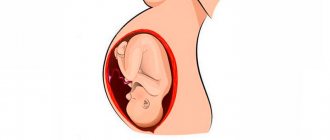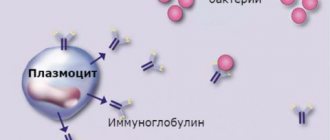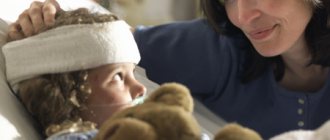Concussion is one of the most common diagnoses in pediatric traumatology. Overall, traumatic brain injury (TBI) ranks first among all childhood injuries requiring hospitalization. Approximately 120 thousand children with concussion are admitted to Russian hospitals every year.
According to the severity, traumatic brain injury is divided into mild (concussion), moderate (mild to moderate brain contusion, with possible fractures of the cranial vault) and severe (severe brain contusions, intracranial hematomas with compression of the brain, fractures of the base of the skull). Fortunately, up to 90% of childhood TBIs are concussions, which is what this article will discuss.
The high level of injuries in children is explained by the child’s increased motor activity, restlessness and curiosity, which is combined with imperfect motor skills and coordination of movements, as well as a reduced sense of danger and fear of heights. In addition, in young children, the head has a relatively large weight, and the skill of belaying with hands has not yet been developed, so small children, as a rule, fall upside down and do not use their hands.
The causes of childhood TBI are very specific to each age group. Newborns in the total mass of victims make up 2%, infants - 25%, toddlers - 8%, preschool children - 20% and school-age children 45%.
Injuries in infants are primarily the result of the inattention and carelessness of their parents. Children under 1 year of age most often (more than 90%!) receive head injuries after falling from changing tables, beds, from parents' arms, from strollers, etc. You should never leave your baby alone in a place where he could fall. If you need to move away from your child at a distance greater than an outstretched hand, do not be lazy, put him in a crib, in a stroller with sides, in a playpen! One or two seconds is enough for the baby to roll to the edge of the changing table and fall.
From 1 year
babies begin to walk. The main cause of TBI is a fall from one’s own height, and a little later - falls from stairs, trees, roofs, windows, slides, etc. The episode of TBI itself is not always possible to identify. It should be borne in mind that if the child remained under the supervision of relatives, neighbors or a nanny, then they can hide from the parents the fact that the baby fell.
Older children
For various reasons, they themselves often hide the trauma.
In addition, children may experience brain damage without direct head trauma. These injuries usually occur when a child's body is subjected to sudden acceleration or deceleration (shaken baby syndrome). “Shaken baby” syndrome is most often observed before the age of 4-5 years
and can occur with rough handling, jumping from heights, and in young children even with excessively intense rocking.
Manifestations of a concussion
With a concussion, there are no gross, irreversible changes in the brain, and such an injury, being the most common, has the best prognosis and very rarely leads to complications.
It should be remembered that the brain of a child (and especially an infant) is significantly different from the brain of an adult. The course of a concussion in adults differs significantly from the course of this injury in a child.
In adulthood, a concussion is manifested by the following main symptoms: an episode of loss of consciousness from a few seconds to 10-15 minutes; nausea and vomiting; headache; amnesia (loss of memory) of events associated with the trauma (before the trauma, the trauma itself and after the trauma). In addition, some specific neurological symptoms are detected, such as nystagmus (twitching of the eyeballs), impaired coordination of movements and some others. The picture of a concussion in a child is completely different.
In children under 1 year
A concussion, as a rule, is asymptomatic. Loss of consciousness often does not occur; single or repeated vomiting, nausea, regurgitation during feeding, pale skin, causeless restlessness and crying, increased drowsiness, lack of appetite, and poor sleep are noted.
In preschool
More often it is possible to establish the fact of loss of consciousness, nausea and vomiting after injury. They experience headaches, increased or slow heart rate, instability of blood pressure, pale skin, and sweating. In this case, moodiness, tearfulness, and sleep disturbance are often noted.
Sometimes children experience a symptom such as post-traumatic blindness. It develops immediately after the injury or a little later, persists for several minutes or hours, and then disappears on its own. The reason for this phenomenon is not completely clear.
The characteristics of a child’s body lead to the fact that a long-term state of compensation can be replaced by a rapid deterioration of the condition. That is, immediately after the fall the child feels satisfactory, but after a while symptoms appear and begin to rapidly increase.
What is meant by the term “concussion” and what are its causes in children?
A concussion is a mild traumatic brain injury and is characterized by the absence of focal damage to the brain.
This pathology is diffuse, all changes occur at the cellular and subcellular level. Thus, identifying a concussion in an adult, and even more so in a child, is a very difficult task even with the use of modern diagnostic methods. Most often, boys suffer from this type of injury, and there is a seasonal fluctuation - the spring-summer period is especially rich in various craniocerebral “incidents”. There is also a tendency towards an increase in the number of concussions in children of preschool and primary school age. The peak incidence occurs between 8 and 12 years of age.
It is not only the direct traumatic agent that has a negative effect on the brain; in other words, neurons will be damaged both at the site of the impact and at a distance from it. At this moment, redistribution of cerebrospinal fluid occurs in the ventricular and subarachnoid spaces. As a result, a hydrodynamic shock occurs, diffusely damaging the cells. Another link in the pathogenesis of concussion is the displacement and rotation of the cerebral hemispheres relative to the rigidly fixed brain stem.
All this leads to disruption of the vascular tone of the cerebral arteries and veins, increased metabolism in cells (the so-called “metabolic fire”), changes in the permeability of the blood-brain barrier, liquorodynamic disorders, as well as dysfunction of the transmission of impulses from neuron to neuron.
Despite the fact that a concussion is a mild form of injury, pathological changes occurring in the brain, if not properly treated, can lead to disability.
The most common causes of concussion in children under one year of age
Most often, children between birth and one year old receive any injuries due to the fault of their parents. This may be a simple oversight and carelessness of young mothers and fathers who, without thinking about the consequences, leave their babies alone on the bed or changing table, in a stroller, in a high chair and walk away, even if only for a minute.
A child can also get a concussion due to excessively active motion sickness, aggressive behavior on the part of adults, or even simply being thrown up. This type of injury, in which there is no effect of the traumatic agent on the skull, is called “shaken baby” syndrome.
Causes of injury in a child aged one to three years
At this age, the child begins to explore the world around him, learns to walk and run. Therefore, among the causes of concussion, falling from height, hitting the head on various furniture, etc. come to the fore. At the same time, children do not have a sense of danger; they do not know how to land correctly with their arms forward.
Also, do not forget about the facts of violence from adults: a small (according to parents) slap in the face can lead to injury.
Concussion in preschool children
Concussions in preschool children also most often occur as a result of unsuccessful landings after a jump, road traffic accidents, hits to the head from sports equipment and merry-go-rounds on playgrounds. Often the cause of injury during this period is a fall from an open window.
Why are schoolchildren so vulnerable to injury?
Schoolchildren receive various types of injuries, including concussions, as a result of their carelessness. This happens due to falls from trees, garage roofs, and extreme sports. Fights contribute a lot to this.
We are taking urgent measures
What should parents do if their child has suffered a traumatic brain injury? There is only one answer: the child should definitely and urgently be shown to a doctor. It is best to immediately call an ambulance, which will definitely take the child to a hospital with pediatric neurosurgeons or neurologists. And this measure is not unnecessary. With minimal symptoms and complaints, the baby may have severe brain damage. The long-term visible well-being of the child, the absence of symptoms, especially with hemorrhages in the brain, often after a few hours and even days is replaced by a progressive deterioration of the condition, which begins with a change in the child’s behavior, his increased excitability, there may be nausea, vomiting, nystagmus, and in infants the fontanelle bulges , then drowsiness appears, depression of consciousness is observed.
Causes of concussion
Concussion is a fairly common injury in children. The frequency of this injury is explained by the mobility and hyperactivity of children. This injury may occur if the child:
- stumbled;
- fell;
- hit;
There are also more serious causes of concussions - car accidents, criminal acts, etc.
A concussion is considered a minor brain injury, but medical intervention, examination and treatment should not be neglected. When diagnosing a concussion, the first step is to determine whether the child needs hospitalization or whether this is not necessary. It is worth noting that mild concussions can be successfully treated at home: it will be more convenient and enjoyable for both the baby and his parents. Doctors note that an examination by a neurologist is mandatory even for mild forms of concussion, when treatment occurs at home.
Diagnosis of concussion
In the hospital, the child is examined by a pediatric neurologist, neurosurgeon or traumatologist. He carefully ascertains complaints, collects anamnesis (history of the disease), and conducts a general and neurological examination. Additional diagnostic methods are prescribed. The main ones are skull radiography, neurosonography (in young children), echo-encephalography (Echo-EG). If necessary, computed tomography of the brain (CT), magnetic resonance imaging (MRI), electroencephalography (EEG), lumbar puncture.
Radiography
skull is performed in most patients. The purpose of this study is to identify skull fractures. The presence of any damage to the bones of the skull automatically transfers the injury to the category of moderate or severe (depending on the condition of the child). Sometimes in young children with a favorable clinical picture, linear fractures of the skull bones are revealed on radiographs. It is impossible to judge the state of the brain substance from radiographs.
Neurosonography
(NSG) is an ultrasound examination of the brain.
Neurosonograms clearly show the substance of the brain and the ventricular system. You can identify signs of cerebral edema, areas of contusion, hemorrhages, and intracranial hematomas. The procedure is simple, painless, quickly performed, and has no contraindications. It can be done multiple times. The only limitation of neurosonography is the presence of so-called “natural ultrasound windows” - a large fontanelle or thin temporal bones. The method is very effective in children under 2 years
. Later, ultrasound becomes difficult to pass through the thick bones of the skull, which dramatically degrades image quality. Equipment for performing neurosonography is available in most children's hospitals.
Echo-encephalography
(Echo-EG) is also an ultrasound research method that allows you to identify displacement of the structures of the midline of the brain, which may indicate the presence of additional space-occupying formations of the brain (hematomas, tumors), and provide indirect information about the state of the brain substance and the ventricular system. This method is simple and fast, but its reliability is low. Previously, it was widely used in neurotraumatology, but with the availability of modern diagnostic tools, such as neurosonography, computed tomography and magnetic resonance imaging, it can be completely abandoned.
The ideal method for diagnosing brain damage and diseases is computed tomography.
(CT). This is an x-ray research method in which high-definition images of the skull bones and brain matter can be obtained. CT can diagnose almost any damage to the bones of the vault and base of the skull, hematomas, bruises, hemorrhages, foreign bodies in the cranial cavity, etc. The accuracy of this study is very high. Its main disadvantage is that the CT machine is expensive, and not every hospital has it.
Magnetic resonance imaging
(MRI) is the most accurate, but complex and expensive method of examining the central nervous system. It is rarely used to diagnose acute traumatic brain injury because it does not allow the bones of the skull to be seen, is less accurate for recognizing acute hemorrhages, takes longer than computed tomography, and often requires anesthesia when examining small children - the child must lie absolutely still for 10 -20 minutes, but small children cannot do this; In addition, very few clinics can boast of having magnetic resonance imaging scanners.
Advertising
Electroencephalography
(EEG) allows you to study the bioelectrical activity of the brain. It is used for special indications to assess the severity of traumatic brain injury and identify foci of epileptic activity. A focus of epiactivity is an area of the cerebral cortex with pathologically altered activity of neurons (nerve cells), which can lead to epileptic seizures.
Lumbar puncture
- this is the collection of cerebrospinal fluid (the fluid that bathes the brain and spinal cord) from the spinal canal at the lumbar level. Changes in the cerebrospinal fluid may indicate injury or hemorrhage (the presence of blood) or an inflammatory process, meningitis. Lumbar puncture is performed extremely rarely and only for special indications.
Signs of a concussion in a child
The most common symptoms of a concussion in children are:
- brief loss of consciousness (usually less than a minute);
- temporary loss of orientation in space;
- weakness:
- headache;
- reading difficulties;
- It may also be difficult for a child to focus his or her gaze on something.
When diagnosing a concussion, it is very important to know whether the parents saw the fall or blow of the child. If parents saw their child fall or hit, it will be easier for doctors to find out exactly how it happened, whether the child lost consciousness after the blow or not, where he fell from or from what height, what he hit, how strong the blow was. In addition, it is important for doctors to understand whether the child remembers what happened to him. In medical practice, a condition when a person does not remember the events that happened to him is called retrograde amnesia.











